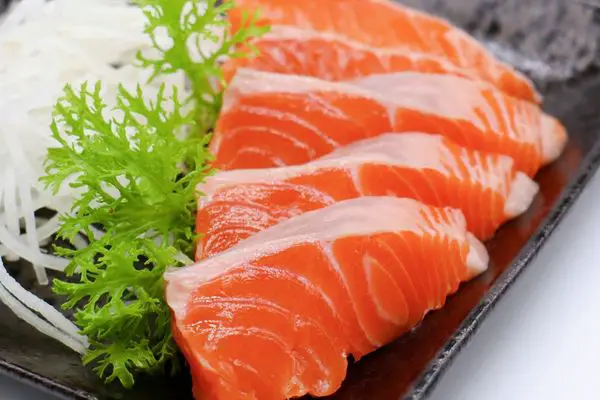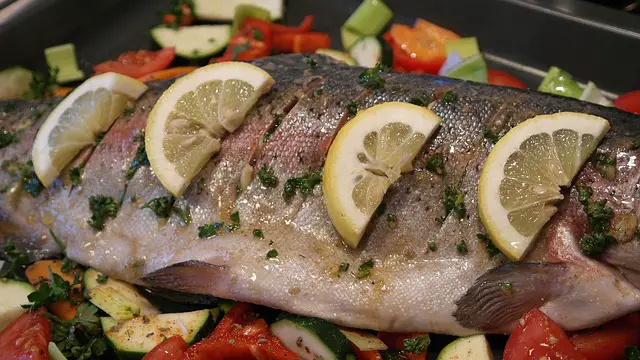Trout is both a popular table fish, as well as a sports fish. Some anglers rate their recreational value over their table value so choose to practice catch and release. I personally, do not rate trout that highly for eating. I feel there are plenty of other fish which taste better, but over the years I have taken enough trout home to have a pretty firm opinion on their eating value.
The eating quality of trout varies greatly depending on where they live and what they are feeding upon. Trout which feed predominantly on crawfish, prawns, krill, and baitfish tend to have the best eating quality. While hatchery trout which grew up on a diet of pellets can taste bland. Other trout can take up the flavors of their environment. A trout that lives in a muddy stream can develop bitter characteristics.
In my opinion, the best eating trout are sea-run fish. I find anadromous trout have flesh and taste resembling that of salmon. Red and flavorsome with no unpleasant tones. Even after returning to the river, the flesh maintains the eating quality for quite some time. I personally consider a nice plump sea run trout has the best eating quality. Species does not matter, both Steelhead and sea-run browns taste good.
On the other end of the spectrum, trout that live in waterways with a muddy bottom often pick up the taste of their environment. These trout largely feed upon nymphs, snails, and other insect life. The flesh can taste bitter, musty, and even muddy.
I personally do not consider them good eating, I even hear other anglers refer to them as mudfish. Still, many people can not tell the difference. A trout is a trout to them. I guess everyone has different sensitivities to different flavors.
Factors that make a trout good to eat?
The flavor and eating quality of trout is heavily influenced by their environment. The biggest factors by far are diet and overall condition. Is it a fat healthy fish in good condition, or a living skeleton on its way out?
I find the best eating trout are fish that feed predominantly on larger prey. Whether it’s other baitfish, krill, prawns, crawfish. The more predatory the tastier they become. These trout also tend to be fatter, and in better condition. They simply taste better on the table.
One possible exception is trout which have been feeding upon mice. I personally have never eaten a mouse trout. But I knew someone who had, and he reported the flesh tasted a bit strange. Just something to keep in mind before taking a trout fat full of rodents home for dinner.
Diet is not the only consideration. I much prefer to eat fish from clean flowing water, preferably with a gravelly or stone bottom. I also tend to prefer river trout, over trout which live in lakes. But that might just be a confirmation bias on my part.
I also will note, trout post-spawn, can be little more than a swimming skeleton. They make for bad eating. I once had the unpleasant experience of filleting and eating one.
How about the nutritional value?
Diet and condition again can greatly change the nutritional value of any meat. A wild trout that lives in a stream will nutritionally be different from a steelhead or a farmed stock trout.
Assuming the same species of trout, the fatter they are, the more calories there is more calories per gram but less protein. This holds true for any animal.
I included the chart below, just to highlight how much variation there can be in the nutritional value of trout. I do not know the sources of the various fish, but if I had to guess that rainbow (A), and the steelhead likely lived in saltwater farm, while rainbow (B) and the wild rainbow were living in freshwater.
| Farm Rainbow (A) | Farm Rainbow (B) | Steelhead | Wild, Rainbow | |
| Calories | 141 | 107 | 143 | 101 |
| Total fat | 6.2g | 5.4g | 6.3g | 2.9g |
| Cholesterol | 59mg | 49mg | 58mg | 50mg |
| Sodium | 51mg | 27mg | 54mg | 26mg |
| Protein | 20g | 14g | 20g | 17g |
Do stock trout taste better than wild trout?
This question is a real can of worms. I have heard people passionately argue both sides. Some people love eating stock trout. They fill their cooler with their limit and take them home. I personally consider this a case of personal preference and what the angler grew up eating but when given the choice most fishermen seem to prefer the taste of wild trout (unless it tastes like mud).
Hatchery trout often taste bland with almost insipid flesh. Others say, their flesh somewhat resembles that of cat pellets and can have a slight nutty characteristic. I have heard them called Purina trout.
This does make quite a bit of sense, fish pellets and cat nuts do share many of the same ingredients. Basically, grind up marine life and some grain for filler. If you like the taste of cat nuts, then a hatchery-raised trout might just be a special treat.
Now, the longer a hatchery trout spends in the wild. The better and more intense the flavor becomes, so holdover trout can start tasting like wild trout, and depending on the diet that can be either good or bad.

Do brown trout taste better than rainbow trout?
No, I do not believe there is a significant difference between the two species and any difference in flavors comes down to environmental variables such as water quality, diet, and their overall condition. Are they fat and plump or malnourished and on their way out?
I will add, that rainbow trout do prefer to live in faster flowing water so are less likely to taste muddy than brown trout.
What does brown trout taste like?
The flavor of brown trout is mild and delicate often described as earthy, similar to the smell of moist soil. This common flavor characteristic likely originates from their diet which is heavily based on nymphs. Brown trout from hatcheries or fish farms often develop slight nuttiness characteristics and tend to be less flavorsome than their wild counterparts.
Finally, Brown trout, including sea run brown trout which have been feeding upon crustaceans or baitfish often develop a much deeper richer more oily flesh. Its flavor profile is much more representative of salmon, gone are the nutty, earthy characteristics commonly associated with the species.
What does rainbow trout taste like?
I am going to answer this in three sections. Wild, stock, and steelheads (anadromous rainbow trout) all have distinctive flavors.
Wild rainbow trout have a mild, somewhat sweet flavor. If it was living on a heavy insect-based diet, its flesh might develop a slight earthiness. It does not taste significantly different from other species of trout sharing the same habitat.
Stock and farmed rainbow trout can taste even more mild and delicate. At times the flesh develops a slight nuttiness, farm rainbow trout are often in all good condition so the flesh can be oily making the taste somewhat richer.
While Steelheads or anadromous rainbow trout have grown fat on marine life. The flesh of steelheads closely resembles that of salmon. It is darker in color, and often redder than river rainbows, and often richer in flavor. Unless they are farmed steelheads, the flesh is unlikely to have nutty tones.
One final point, the longer a steelhead spends in the river the more the eating quality is likely to deteriorate. This is because their river diet is not as nutritious as in the sea. They also seem to feed less close to spawning so their condition can suffer. A fat trout tastes better than a skinny trout.
What does brook trout taste like?
Like all species of trout, the flavor of Brook trout largely reflects their diet. The flesh is mild and usually delicate in flavor. Stream living brook trout often taste sweet and earthy.
I can not comment on the taste of Salter, or anadromous brook trout because I have never tried it, but I can not imagine it tasting significantly different from searun brown trout or steelhead.


Totally agree. Wild trout taste much better than stocked trout which are feed on high protein pellets.. All such fish should be returned alive..